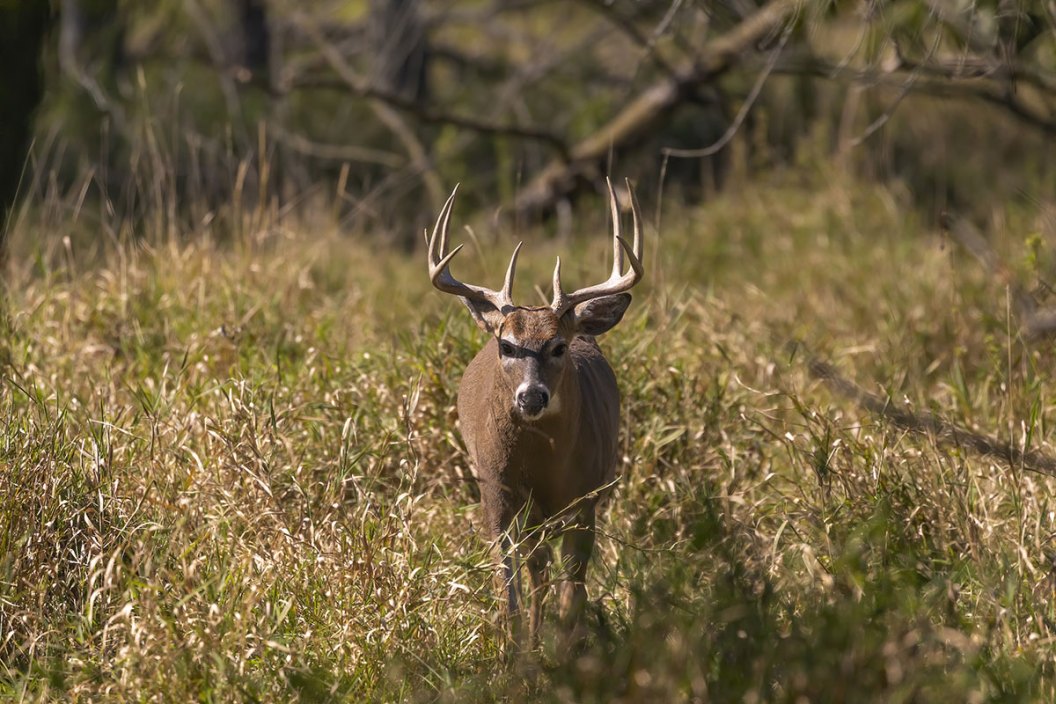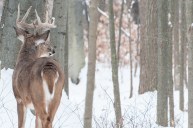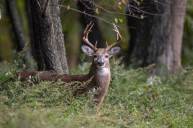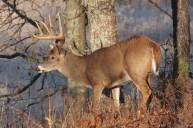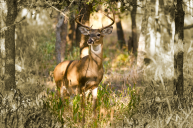Here's your last stop of your information gathering for Minnesota deer hunting.
The upper midwest state of Minnesota has many nicknames, but while the Land of 10,000 Lakes certainly loves and promotes their fishing, it's the whitetail deer hunting in the state that deserves more attention.
Minnesota is bordered by the Dakotas to the west, Iowa to the south, and Wisconsin to the east, not to mention the very western portion of Ontario, Canada on its northern border.
All of this makes the 12th largest U.S. state by area one of the best outdoor recreation stops in the Lower 48. Yes, water sports can consume travelers and residents of Minnesota due to the vast amount of recreational activities available like boating, fishing, and canoeing in the summer. But when the temperatures begin to drop, deer hunting absorbs the minds of sportsmen and women in the state.
The fact is that Minnesota has some of the best hunting for whitetail deer in the land. In years past the Minnesota Department of Natural Resources reported that close to 200,000 registered deer per year are taken by hunters, although the numbers have dropped since the two harsh, deep-snow winters of 2014-15.
Even at that, 175,000-190,000 deer are taken each hunting season by resident and non-resident hunters alike. That spells positivity for deer numbers n the state.
Hunter numbers in the Gopher State are strong, as the Grand Forks Herald reported an average sale of 520,000 hunting licenses each for firearms, muzzleloader and archery deer seasons.
Minnesota Deer Hunting Season
The 2020 Minnesota firearms deer hunting season for northeastern Minnesota, known as the 100 series permit areas, runs for just over two weeks, from Saturday, Nov. 7 through Sunday, Nov. 22. The 200 and 300 series permit areas run Nov. 7-15.
Hunters statewide need to know that the legal shooting hours are from one half hour before sunrise to one half hour after sunset. As in many states, a legal buck is classified by having at least one antler that is 3 inches long or longer.
For residents who wish to deer hunt, the license fee is $35, but non-resident hunters will need to shell out $185 for a deer hunting license. A good piece of information to know is the any hunting license purchased after the opening day is only valid the next day after it is purchased, not on the day it is issued.
Any and all hunters (and trappers) in the field during an open firearms deer season must wear blaze orange or blaze pink on the visible portion of the hunter's cap and outer clothing above the waist.
Another point of reference that hunters using public land wildlife management areas need to know is that,
Successful deer hunters must sign onto the Minnesota DNR's electronic license system to legally register a harvest online at mndnr.gov/gameregistration. Deer can also be registered by calling 888-706-6367 or in person at designated registration stations.
Deer hunters in the state of Minnesota are reminded that they may not take deer by the use of bait. The authorities have also listed the top 10 reasons that deer hunters were cited with violations in the state during the 2019 deer season:
- Uncased/loaded firearms in vehicle
- Failure to register deer
- Failure to validate registration
- Hunting over bait
- No license
- No license in possession
- Untagged deer
- No legal blaze orange clothing
- Lending or borrowing a license or antlerless permit
- Trespassing
Deer Hunting Minnesota
Northern Minnesota and Central Minnesota are energetically known as having the best deer hunting in the state, particularly public land hunting. Central Minnesota, from around Park Rapids to Brainerd, reportedly has some of the highest deer numbers in the state according to the DNR. Itasca State Park, for instance, has nearly 32,000 acres of old growth forest and the local bucks seem to keep growing bigger and bigger every year. This just adds to its already high deer density.
Superior National Forest in northern Minnesota has a whopping 3 million acres of huntable land. This vast area offers some of the most classic big-woods hunting styles that you can imagine, from a canoe trip in the Boundary Waters area to a lakeside hunting cabin with an added ATV.
According to the USDA Forest Service, hunting is allowed on all Superior National Forest lands, including the Boundary Waters Canoe Area Wilderness, except within the limits of developed recreation sites such as campgrounds and boating sites.
Hunters using the Superior National Forest need to be aware of the recently revised Forest Plan which now includes some new policy regarding off-highway vehicle use on Superior National Forest lands.
Deer numbers generally increase the further west you go, which is home to more productive habitat such as agriculture areas mixed in with rolling terrain dominated by managed forests.
Venerable areas such as the Detroit Lakes and Milaca are more known as ruffed grouse, prairie chicken, and pheasant areas, but also offer some good deer hunting. Run River State Forest offers 40,000 acres of land for hunting use.
Chronic Wasting Disease (CWD) in Minnesota Deer
Unfortunately, Minnesota has been found to have deer that have tested positive for Chronic Wasting Disease steadily for several years now. As part of the DNR's response to CWD, a sampling is voluntary for all deer harvested in the east central CWD surveillance area, and in the southern Pine and Chisago counties. The Minnesota DNR encourages hunters to help with this process by providing the head of any harvested adult deer (1 year or older) at self-service sampling stations during any deer hunting seasons.
It is also voluntary, but strongly requested, for the north central CWD Control Zone, west of Aitkin in the Brainerd area where both wild deer and deer farm raised deer have tested positive for CWD. Since it takes time to receive CWD test results, timing will vary depending on the number of samples collected. Deer hunters are recommended to process their deer as they normally would.
CWD sampling stations are accessible during the firearms deer season for varying lengths of time: until the goal of 1,000 tested deer is reached in the east central area, and all season in the north central area.
Early Antlerless Deer Season
Hunting regulations in Minnesota include a limit of five deer during the early antlerless season, which is in addition to the statewide bag limit of one legal buck, giving the state one of the most liberal freezer-filling deer seasons anywhere. There are some exceptions to those limits, and can be viewed via the most updated information on the DNR's website.
The early antlerless season coincides with the special youth deer season in deer permit areas listed. To participate in the early antlerless season, hunters must possess an archery, firearm or muzzleloader license and at least one valid early antlerless permit.
Youth can take one deer of either sex during the early antlerless season by using their youth season license and bonus permits may be obtained, but hunters still must possess at least one other valid early antlerless permit.
Minnesota Hunting
Every fall, hundreds of thousands of hunters clad in blaze orange and blaze pink head out in search of Minnesota's whitetail deer, and along with them the hopes and dreams of their own deer hunting lives. Minnesota has many areas that provide good habit for deer to survive and thrive, and its meandering streams and deep valleys have some of the most beautiful scenery anywhere.
Now it's just a matter of choosing the right place, and getting out there!
Looking for a little more or even hot lunch for your hunting blind? Follow my webpage, or on Facebook and Twitter.
